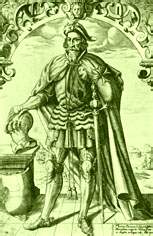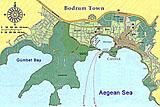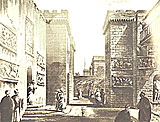|
A visit to Bodrum's Castle of St.
Peter is a must-see in Bodrum, and many visitors are surprised to find such riveting blend of ancient and modern
behind those imposing stone walls.
Whether viewed from the land or the sea, Bodrum's famous castle is an impressive example of
medieval architecture. Occupying some thirty thousand square feet at its base, construction of the castle took
years to complete. In its days, the castle was a monumental symbol of the unity of Christian Europe against the
ascending power of the Ottomans.
The castle is in excellent condition, it now houses a remarkable museum (with exhibits on
underwater archaeology). The walls of the castle are studded with some 249 coats of arms. A lot of the stones used
in the construction come from the tomb of king Mausolus (†353 BC). One of the Seven Wonders of the world, its massive
construction survived for centuries until an earthquake brought it down in medieval times. The knights used the
ruins as a quarry. While reinforcing the castle in 1522, they even discovered the funerary chamber of the king,
whose treasures were quickly looted. Almost nothing remains on the site of the Mausoleum, but the frieze which
decorated the castle was taken to London in the 1830s, and smaller architectural elements still remain, their white
marble readily visible.
In the 15th century, the Knights of St John invaded the region (whose headquarters were on
Rhodes) and began constructing the castle we see today.
Building materials were not hard to come by; just across the bay from the castle was the
collapsed ruin oft he once magnificent Mausoleum, one ofthe Seven Wonders of the Ancient World. By the 13th century
this edifice had long been toppled by earthquakes, and the Knights were quick to recognise the usefulness of so
much ready masonary. Many of these greenish blocks can easily be recognised in the castle walls today.
|
One of the knights named
La Touret describes the plundering of the tomb in his memoires, saying:
"First we found the stairs leading down to the burial chamber below the ground and we were breathless at the
spectacular sight in front of our eyes. The second minute we started looting the place, but we didnt have much
time, because they commanded us back to the castle. The next day when we came back to the same site, precious gold
jewelry and pieces of fine cloth were scattered around the place ...."
|
The burial chamber still seen today , was most probably robbed much earlier than the theft by the Knights of Rhodes.
Groups of English, French, and German knights undertook the work and its financing. Today, the towers of the castle
are named after the countries that paid for their construction: English Tower, German Tower, and so on. In addition
to these, there is another tower, 'Liman' or 'Harbor' Tower, that now serves as the main entrance to the castle.
As originally constructed, this tower stood in the sea which has since been filled in. Another gate, called the
'Northern Moat Entrance', opens into the main plaza of Bodrum and originally was the castle's landward entrance.
The land on which the castle stands was, at one time an island known as Zefirya, after Zephyros, the god of the
west wind. The castle is thought to occupy the sites of what were the palace of King Mausolos and of a temple dedicated
to Apollo, the principle deity worshipped by the Halicarnassans. Remains of the palace defensive walls are thought
to still exist. The island was joined to the mainland in Hellenistic times, when Halikarnassos was part of the
kingdom of Pergamon.
Examining the defense system of the castle, the first thing one notices is that the walls
on the landward side are much stronger than those on the seaward side. This was because the chief threat to the
castle, the Ottomans, would have come from that direction. In those days, threats from the sea would have been
less of a worry because the Knights of Rhodes kept the Aegean under their strict control.

|

|
|
|
Sir Thomas Docwra
Leader of the English Langue
|
|
In its heyday, the castle was probably manned by fifty knights and perhaps three times that
many ordinary soldiers. The knights hailed from seven different European countries and shared in the defense of
the castle and its countryside. The castle's defenses were never put to the test, for the Ottomans never attacked
it. Instead in 1522, they besieged the island of Rhodes led by their sultan, Süleyman the Magnificent. After
holding out for three months, terms were agreed to, under which the Knights had to evacuate Rhodes and five other
of their strongholds in the eastern Mediterranean. Petronium was one of them. In January of the following year,
the Knights set sail, eventually ending up on Malta in 1530.
The subsequent military history of the castle is rather insignificant. In 1770 the Russian
fleet bombarded it briefly. During the first world war, the French did the same but with somewhat more success:
they managed to demolish one side of the English Tower.
Bodrum was occupied by the Italians during the same war and while here, they used the castle as a base, and rebuilt
the Italian Tower in the form we see today. In the decades following the establishment of the Turkish Republic
(1923), thecastle suffered from neglect and decay. A few dwellings were built inside and the mosque and bath were
used but in the main, people seem to have avoided it.
In the 60s, a decision was made to turn the castle into an archaeological museum. In the
years since then, it has been undergoing restoration. Today, it is one of the world's most distinguished museums
specializing in underwater archaeology though it also has a fine collection of other antiquities as well.
More of the museum  here here
The Castle
The Castle of the Hospitaller Knights occupies the tip of the wedge-like peninsula at the center of Bodrum. It
is a splendid incarnation of medieval western military architecture, built at a time when the European Middle Ages
were quite over and castles of this type were fast becoming objects of nostalgia. Its massive conglomeration of
courtyards, turrets, crenellated walls, galleries and sunken gardens is best explored in the stillness of noon..
Amateurs of heraldry may recognize the Plantagenet, d'Aubusson, Loredan and other prominent coats-of arms on the
ramparts. Much to the delight of the tourist guides, each of the five turrets are called by the nationality of
their original sponsors: the English, French, German, Italian and Spanish Towers. Parts of the walls are built
of large slabs of greenish granite which the knights removed from the ruins of the Mausoleum. Other classical fragments
are gathered for display in the inner courts. Peacocks strut among marble statues and mollusk-encrusted amphorae.
As interesting as the castle itself are the collections of the Museum of Underwater Archeology housed within the
premises. The museum, the most important of its kind in the world, is the brainchild of Professor George Bass,
and his Institute of Nautical Archaeology, and contains treasures from a series of historic wrecks discovered on
Turkey's southern shores. Mycenaean and Canaanite artifacts recovered from a l2th century B.C. wreck found off
Cape Gelidonya (Antalya) in 1960 formed the original core of the museum. On display in the castle's Gothic Chapel
is a full scale reconstruction of one third of an Eastern Roman wreck from the 7th century A.D. excavated by Dr.
Bass. Finds from the world's oldest known shipwreck, a 14th century B.C. vessel recently excavated off Uluburun
(Kas), will soon join the collection. The Italian Tower houses coins and jewelry from all periods. Most impressive
of all is the Glass Hall containing a spectacular cargo of medieval glassware from an 11th century Islamic wreck.

|

|

|

|
|
 The castle of St Peter is
the landmark of Bodrum and hosts a museum of a special kind The castle of St Peter is
the landmark of Bodrum and hosts a museum of a special kind

|
|

|
|

|
|

|
|

|
|

|
|

|
|

|
|

|

|

|
|
 on an engraving from around 1800 the friezes
guild in the walls of the castle can still be seen on an engraving from around 1800 the friezes
guild in the walls of the castle can still be seen

|
|

|
|


|
|